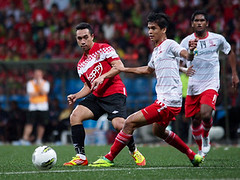Soccer(Football) is an intermittent sport characterized by ~1200 acyclical and unpredictable changes in activity (each every 3 to 5 s) involving, among others, 30 to 40 sprints, more than 700 turns, and 30 to 40 tackles and jumps. In addition, the game requires other intense actions such as decelerations, kicking, dribbling, and tackling. All these efforts exacerbate the physical strain imposed on the players and contribute to making soccer highly physiologically demanding. Computerized time motion and semiautomatic video-based system analyses have revealed that top-class football players perform 2 to 3 km of high-intensity running (>15 km/h) and ~0.6 km of sprinting (>20 km/h).Furthermore, these distances of running and sprinting are, respectively, 28% and 58% greater than those of moderate level professional players. In addition, the less successful teams exhibit greater decrements in the total sprint distance covered during the match, suggesting that the ability to perform high-intensity activities throughout a game is very important.
Each playing position is characterized by its own activity profile and different tactical requirements in relation to the movement of the ball. Central defenders cover less total distance and high-intensity running, while attackers complete more sprints and a greater portion of high-intensity activity when their own team is in possession of the ball than midfielders and defenders.
During the second half of a match, the total distance and high-intensity running decline markedly, with the amount of high-intensity running 20% to 40% lower in the last 15 min of the game compared with the initial 15-min period. A greater decrements in running is observed when more activity is performed in the first half. Furthermore, in the 5 min following the most demanding 5-min period of the game, the distance covered at high intensity is reduced by 6% to 12% compared with the game average. Collectively, these results indicate that players experience fatigue toward the end of a match and temporarily during a game. Accordingly, both single and repeated-sprint test performances are impaired after a high-intensity period during as well as at the end of the game. Fatigue may also have a negative impact on passing precision, with the less fit players showing a more pronounced deterioration in technical performance. It appears that modern soccer is physically demanding and players need a high fitness level to cope with the energy demands of the game.



No comments:
Post a Comment